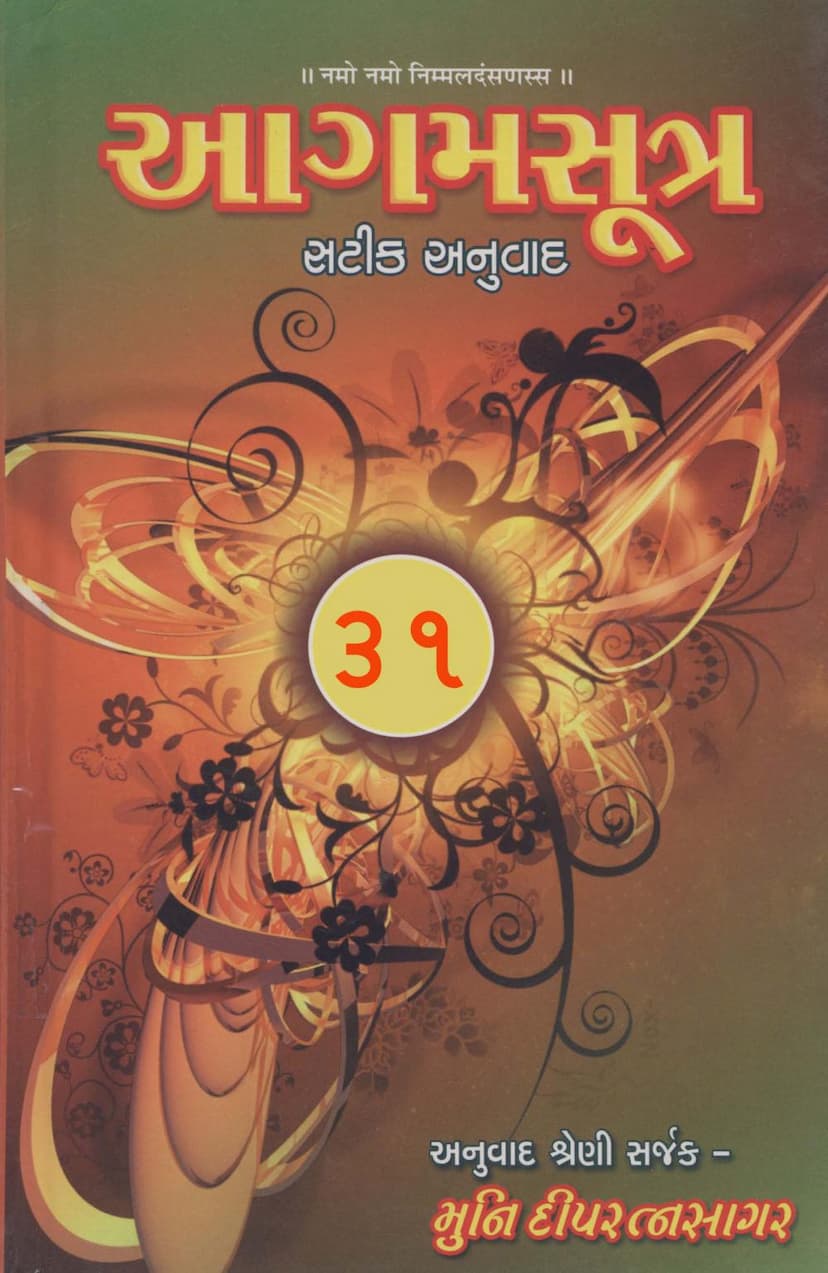Agam Satik Part 31 Aavashyak Sutra Gujarati Anuwad 1
Added to library: September 1, 2025

Summary
The provided text is a Gujarati translation and commentary of the Aavashyak Sutra, which is part of the Jain Agamas. This specific volume, Agam Satik Part 31 Aavashyak Sutra Gujarati Anuwad 1, is the first part of the Aavashyak Sutra's commentary and translation.
Here's a breakdown of the content based on the provided pages:
-
Title and Author: The book is titled "Agam Satik Anu-vaad" (Agam Sutra with Commentary Translation) and is part of a series. The author is Munishri Dipratnasagarji, also referred to as Deepratnasagar. The publisher is also Deepratnasagar.
-
Volume and Content: This is Volume 31 of the series and specifically covers the Aavashyak Sutra. It includes the Niryukti (commentary) from verse 1 up to verse 563. It's important to note that the actual Mool Sutra (original text) of the Aavashyak Sutra begins after Niryukti verse 886. Therefore, this particular volume (Part 31) focuses solely on the introductory parts, including the commentary (Niryukti) and its explanation (Vritti) until the 563rd verse of the Niryukti.
-
Introduction to Aavashyak Sutra: The text explains that the original Aavashyak Sutra is concise, consisting of only 92 verses spread across six chapters. However, its Niryukti alone contains 1623 verses. When combined with the Bhashya (another layer of commentary) and the Haaribhadriya Teeka, the text becomes extensive. The Niryukti and Vritti are rich in subject matter, narratives, and examples.
-
Key Themes within Aavashyak Sutra: The Aavashyak Sutra deals with six essential topics:
- Samayik (Equanimity/Meditation)
- Chaturvinsatistav (Praise of 24 Tirthankaras)
- Vandan (Salutations)
- Pratikraman (Confession/Repentance)
- Kayotsarg (Self-relaxation/Body abandonment)
- Pratyakhyan (Abstinence/Renunciation)
-
Commentary Basis: The translation and commentary primarily rely on the Niryukti, Bhashya, Jainadasagani's Churni (commentary), and Haaribhadriya Vritti. The text acknowledges the importance of other commentaries like the Visheshavashyak Bhashya and Malayagiri's Vritti.
-
Purpose of the Work: The translation aims to make the profound teachings of the Aavashyak Sutra, especially its intricate commentaries, accessible to those who may not be proficient in Sanskrit and Prakrit. It highlights the extensive scriptural knowledge contained within the Agamas.
-
Structure and Detail: The text then delves into a detailed explanation of the Pithika (Introduction) and Upaodghat Niryukti (Preliminary Commentary), covering various Jain philosophical concepts. This includes discussions on:
- Mangal (Auspiciousness): The importance of auspicious beginnings, their meaning, and their necessity in scriptural works.
- Pancha Gyan (Five Types of Knowledge): Detailed explanations of Abhinibodhic (sensory), Shrut (scriptural), Avadhi (clairvoyance), Manahparyav (mind-reading), and Keval (omniscience) knowledge.
- Mati Gyan (Sensory Knowledge) Details: An in-depth analysis of the different aspects of Mati Gyan, including its types, their classifications (e.g., Vyjana, Arth), timeframes, and the subtle details of perception.
- Agam Sandarbh (Agamic References): The text references the importance of consulting various Agamas like "Agam-sutrani-mulam," "Agam-Gujarati Anu-vaad," and "Agam-Satika" for further understanding.
- Tirthankara Biographies and Genealogies: A significant portion of the text is dedicated to narrating the lives, lineages, and events related to the Tirthankaras, particularly focusing on Rishabhadeva and Mahavira. This includes details about their birth, upbringing, renunciations, ascetic practices, knowledge acquisition, and the establishment of the Jain Sangha.
- Dravya, Kshetra, Kala, Bhava (Substance, Space, Time, Modality): These fundamental Jain philosophical concepts are applied to explain various aspects of the Agamas and the Tirthankaras' lives.
- Deities and Their Roles: The text mentions the involvement of various deities like Indras, Shikra, and Dikumaris in the lives of Tirthankaras, particularly during their birth and ascetic phases.
- Rituals and Practices: Discussions on rituals like Upasarga (afflictions), Tapa (asceticism), and various forms of meditation (Samayik, Kayotsarg) are presented.
- Nirvana (Liberation): The text touches upon the ultimate goal of liberation, achieved through right faith, knowledge, and conduct.
-
Acknowledgements and Support: The book acknowledges the financial support from various Jain Sanghas and trusts, indicating that the publication of such extensive religious literature is a collective effort.
In essence, this volume serves as a foundational text for understanding the Aavashyak Sutra, providing a detailed and scholarly commentary that delves into the philosophical, biographical, and ritualistic aspects central to Jainism. It aims to elucidate complex Jain doctrines through a blend of the original scriptural text, commentaries, and explanatory narratives.